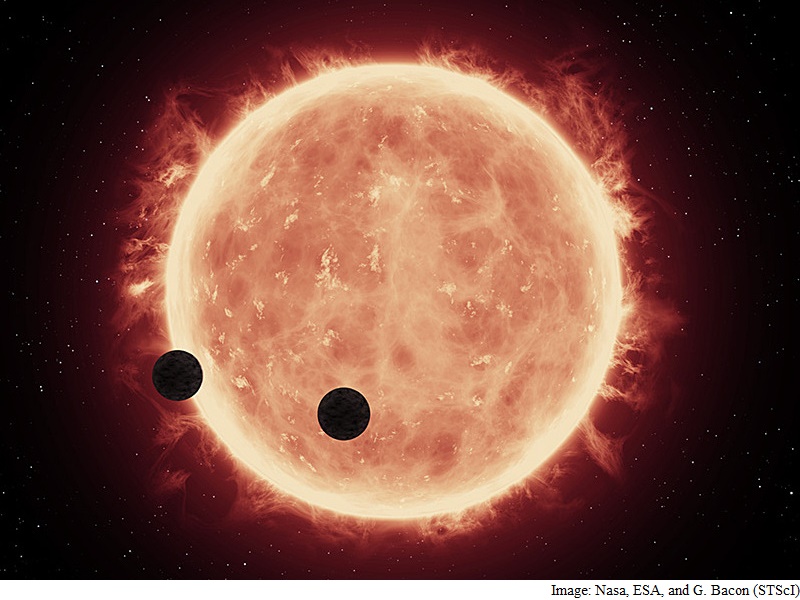- Home
- Science
- Science News
- Two Earth Like Exoplanets May Harbour Life, Shows Hubble Data
Two Earth-Like Exoplanets May Harbour Life, Shows Hubble Data

The exoplanets TRAPPIST-1b and TRAPPIST-1c - approximately 40 light years away - are unlikely to have puffy, hydrogen-dominated atmospheres usually found on gaseous worlds.
"The lack of a smothering hydrogen-helium envelope increases the chances for habitability on these planets," said team member Nikole Lewis from Space Telescope Science Institute (STScI) in Baltimore.
"If they had a significant hydrogen-helium envelope, there is no chance that either one of them could potentially support life because the dense atmosphere would act like a greenhouse," he added.
The planets orbit a red dwarf star at least 500 million years old, in the constellation of Aquarius.
TRAPPIST-1b completes a circuit around its red dwarf star in 1.5 days and TRAPPIST-1c in 2.4 days.
The planets are between 20 and 100 times closer to their star than the Earth is to the Sun.
Because their star is so much fainter than our sun, researchers think that at least one of the planets, TRAPPIST-1c, may be within the star's habitable zone, where moderate temperatures could allow for liquid water to pool.
Julien de Wit from the Massachusetts Institute of Technology led a team of scientists to observe the planets in near-infrared light using Hubble's Wide Field Camera 3.
They used spectroscopy to decode the light and reveal clues to the chemical makeup of an atmosphere.
"These initial Hubble observations are a promising first step in learning more about these nearby worlds, whether they could be rocky like the Earth, and whether they could sustain life," said Geoff Yoder, acting associate administrator for Nasa's Science Mission Directorate in Washington.
"This is an exciting time for Nasa and exoplanet research," he added.
The researchers hope to use Hubble to conduct follow-up observations to search for thinner atmospheres, composed of elements heavier than hydrogen, like those of the Earth and Venus.
"With more data, we could perhaps detect methane or see water features in the atmospheres, which would give us estimates of the depth of the atmospheres," noted Hannah Wakeford from Nasa's Goddard Space Flight Centre in a paper appeared in the journal Nature.
Observations from future telescopes, including Nasa's James Webb Space Telescope, will help determine the full composition of these atmospheres and hunt for potential bio-signatures.
Webb also will analyse a planet's temperature and surface pressure - key factors in assessing its habitability.
For the latest tech news and reviews, follow Gadgets 360 on X, Facebook, WhatsApp, Threads and Google News. For the latest videos on gadgets and tech, subscribe to our YouTube channel. If you want to know everything about top influencers, follow our in-house Who'sThat360 on Instagram and YouTube.
Related Stories
- Galaxy S24 Series
- MWC 2024
- Apple Vision Pro
- Oneplus 12
- iPhone 14
- Apple iPhone 15
- OnePlus Nord CE 3 Lite 5G
- iPhone 13
- Xiaomi 14 Pro
- Oppo Find N3
- Tecno Spark Go (2023)
- Realme V30
- Best Phones Under 25000
- Samsung Galaxy S24 Series
- Cryptocurrency
- iQoo 12
- Samsung Galaxy S24 Ultra
- Giottus
- Samsung Galaxy Z Flip 5
- Apple 'Scary Fast'
- Housefull 5
- GoPro Hero 12 Black Review
- Invincible Season 2
- JioGlass
- HD Ready TV
- Laptop Under 50000
- Smartwatch Under 10000
- Latest Mobile Phones
- Compare Phones
- Samsung Galaxy C55
- Blackview Hero 10
- Oppo K12
- Vivo Y200i
- Huawei Pura 70 Pro
- Huawei Pura 70
- Vivo V30e
- Itel Super Guru 4G
- Lenovo IdeaPad Pro 5i
- Asus ZenBook Duo 2024 (UX8406)
- Realme Pad 2 Wi-Fi
- Redmi Pad Pro
- boAt Storm Call 3
- Lava ProWatch Zn
- Samsung Samsung Neo QLED 8K Smart TV QN800D
- Samsung Neo QLED 4K Smart TV (QN90D)
- Sony PlayStation 5 Slim Digital Edition
- Sony PlayStation 5 Slim
- Voltas 1.5 Ton 3 Star Split AC (183 Vectra Elegant 4503545)
- Hitachi 1.5 Ton 5 Star Inverter Split AC (RAS.G518PCBISF)

















